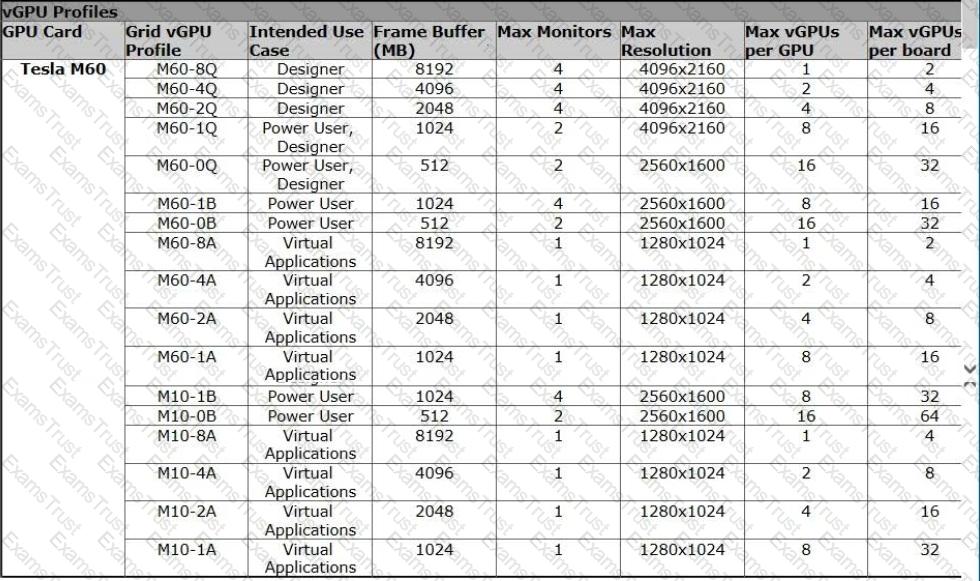During a design workshop, an architect discovers that a customer plans to deploy Arc GIS and AutoCAD applications to a subi of VDI users. The project will scale to 1500 general purpose desktops, 50 AutoCAD users and 25 ArcGIS users. Planned redundancy must allow one host to be removed from any cluster for maintenance while still accomodating all users.
Desktops will be configured for each of the user groups:
• General purpose - 2vCPU, 2GB RAM, 40GB HOD, Windows 7
• AutoCAD - 4vCPU, 16GB RAM, 200GB HOD, Windows 7
• ArcGIS - 4vCPU, 8GB RAM, 500GB HOD, Windows 10
Referring to the exhibit, which two cluster configurations are recomended to support these desktop pools? {Choose two.)

After implementing App Volumes and configuring all of the AppStacks, customers are complaining about slow login times. All AppStacks are hosted on the SAN and each AppStack is assigned to 700 users and includes a minimum of 3 applications per AppStack.
What cost effective change can an architect recommend to improve the issue?
A company wants to reduce updating and provisioning time for problematic legacy applications on virtual desktops.
Which two Horizon technologies can meet the requirement? (Choose two.)
A customer is looking to implement Horizon View Windows desktops for a 500-seat call center operating under these conditions:
Management is frustrated by the lack of productivity that occurs during shift changeover. Logoff and logon processes take in excess of 5 minutes.
The customer has asked an architect to recommend the most cost-effective configuration that provides the shortest possible amount of downtime between shifts.
Which two should the architect choose? (Choose two.)
A company’s IT team wants to provide multiple Microsoft Office suite applications to end users without incurring any Windows desktop operating system licensing fees.
They also want each end users’ Microsoft Office suite application customization settings and configuration changes preserved and restored when the end user logs off and logs back in.
Which two VMware technologies must they deploy to meet the requirements? (Choose two.)
Which ports on a firewall need to be opened to allow client PCoIP traffic to flow from user’s endpoints to a Unified Access Gateway appliance?
An application packaging team is preparing to deploy a new enterprise application for 1000 users.
Application requirements and limitations include:
The organization is only using Horizon hosted applications on Windows 2012 R2. The servers are at 30% utilization. No additional users will be added.
What changes to the Horizon environment will be required to deploy the application?
When determining the number, type, and size of Horizon View components to be installed, which three pieces of information must an architect know? (Choose three.)
A university struggles with Windows application delivery for its students. Students only need a few applications, but since IT is not in control of the Windows versions on the endpoints, it has been a challenge. IT wants to allow for self-service to minimize administration. Despite self-service, IT must be able to revoke access to applications within 30 days from students leaving the University.
Which two solutions support the university’s requirements? (Choose two.)
A hospital is looking to introduce a new work model. Their goal is to allow doctors and nurses to access care applications more flexibly. An important task is that Android and iOS tablets be allowed for hospital staff. The IT department is faced with the task of executing on the requirements.
The current client environment is:
Any solution must be in production within 6 months. IT was approved to start building a non-optimized solution to get things started. At a later date, investments will be spent on optimizing the solution. There is no time for a proper application assessment and user segmentation, so the solution must support as broad a user base as possible.
The main priorities for the design are:
What solution would support the main priorities?
Company A decides to set up a Proof of Concept (POC) environment for VMware Horizon View 7 Advanced. During the base image creation, all the necessary applications and software were installed. The POC was successful and Company A is interested in setting up a View Desktop Pool for a User Acceptance Test (UAT), but a decision was made to use instant clones. When creating a new desktop, the option to use instant clone is greyed out. The same base image has to be used.
Which two steps must be taken to use instant clones for UAT in Company A? (Choose two.)
Which three options need to be considered when implementing multiple vCenter Server in App Volumes 2.x? (Choose three.)